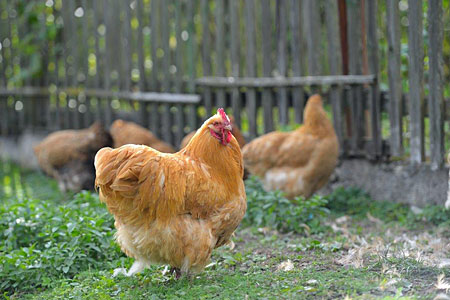
Biosecurity for chickens includes all precautions you take to protect your flock from coming down with a disease. The more precautions you take, the better chance your chickens have to remain healthy. The fewer precautions you take, the greater the risk that one day some disease will affect your flock. So what are these precautions that provide biosecurity for chickens?
Start Healthy
From the get-go, start with healthy chickens. Flocks and hatcheries enrolled in the National Poultry Improvement Plan (NPIP) are certified to be free of several serious infectious diseases. Avoid birds from a live-bird auction, flea market, wheeler-dealer, poultry trader, or any other source that brings chickens together from far-flung places.
You’ll have the best chance of getting disease-free birds if you start with newly hatched chicks. The older the bird, the more disease problems it has been exposed to.
Once you have acquired healthy chickens, your best chance of keeping them healthy is to maintain a closed flock. That means you never take chickens off your property and then bring them back again.
It also means not adding new birds to your flock that originated off site. Chickens can develop immunity only to pathogens they encounter in their environment. So chickens from one environment are not necessarily immune to pathogens encountered in another environment.
Similarly, seemingly healthy chickens from one environment may shed pathogens to which chickens in another environment have never developed immunity. Why take a chance?
If, however, you need to bring in new birds, acquire chicks. And if you think it’s fun to acquire mature chickens, or to exhibit the ones you have, quarantine them for one month when you get them home. Feed the new or returning birds only after you’ve taken care of your other chickens.
Good Nutrition
Like people, chickens need a variety of nutrients to maintain good health. And, like people, the nutritional needs of chickens changes with their age and level of production. So be familiar with poultry feed options and always use the most appropriate ration for your flock.
Along with proper nutrition, chickens should be able to rely on contamination-free feed and water. They should also have enough feed and water stations to accommodate the entire flock.
Clean Housing
The typical backyard flock is housed in a fixed location, which presents a biosecurity challenge: Over years of constant use, pathogens accumulate. Therefore, the single most important feature of any chicken facility is ease of cleaning. If cleanup is a hassle, you won’t do it as often as you ought, and your chickens will suffer for it.
Keep that in mind when developing your coop design. Choose the best design that allows easy cleaning and disinfecting, replacing soiled litter, and revitalizing the chicken run.
Minimize Stress
A chicken has limited energy reserves for coping with day-to-day life. But intense or numerous events or changes cause stress. In attempting to cope, the chicken rapidly uses up its energy reserves. As a result the bird is left with too little energy for both normal daily needs and resisting disease.
Providing a sound environment helps minimize stress. Chickens confined to a backyard shouldn’t have to worry about finding protection from the elements. They should be able to count on clean, dry litter and range. They need good ventilation without draftiness.
Frequently introducing new chickens into your flock not only runs the risk of introducing disease, but also increases peck order stress. If you can’t control your impulse to acquire more chickens, at least minimize stress with careful integration.
Exclude Rodents and Birds
Rodents are attracted to chicken coops by feed, water, and a protective environment — all the same things your chickens enjoy. In exchange, they can introduce diseases to your chickens.
Always assume you have rodents, even though you don’t see them, and take steps to keep them away from your coop. Patch any holes in the walls, no matter how small. Close off any tunnels you find in soil, in litter, or under the floor. Clean up spilled feed. And don’t leave feeders out in the open overnight.
Wild birds also can transmit diseases to chickens. Like rodents, they are attracted to chicken yards by readily available feed and also by suitable nesting sites, such as in the coop’s eaves.
To discourage birds from visiting your chicken yard, don’t provide birdseed or bird nesting boxes in or near the coop. Keep chicken feeders indoors, where they are less likely to attract wild birds. If possible, cover the top of your chicken run with wire or plastic netting that wild birds can’t get through.
Biosecurity for Chickens
No set of biosecurity measures, no matter how carefully followed, is 100% guaranteed to prevent disease. The best you can do to protect your flock is to follow a well-thought-out program of interrelated biosecurity measures based on good old fashioned common sense.
And that’s today’s news from the Cackle Coop.
Gail Damerow is author of The Chicken Health Handbook, which includes extensive details on providing biosecurity for chickens.

